54. Breaking Down Data Silos: 10 Strategies to Unite Your SMB for AI-Powered Growth
A data silo is essentially data trapped in one department, inaccessible to others – think of your sales team and finance team working from entirely different information sources. These silos often develop unintentionally, but their impact is severe: they hinder cross-departmental collaboration, lead to bottle necked data, and slow down decision-making. In fact, knowledge workers lose an average of 12 hours per week just “chasing data” arranging systems instead of making decisions. That is precious time that growing businesses – especially those looking to adopt AI and advanced analytics – simply can’t afford to waste.
Q1: FOUNDATIONS OF AI IN SME MANAGEMENT - CHAPTER 2 (DAYS 32–59): DATA & TECH READINESS
Gary Stoyanov PhD
2/23/202519 min read

1. Establish a Unified Vision and Culture of Data Sharing
The journey to tear down silos begins with culture. Leadership must establish and evangelize a clear vision that “We operate as one team with one data truth.” This cultural shift often requires a top-down mandate. As Peter Drucker famously noted, “Culture eats strategy for breakfast.” You can deploy the best tools and have the smartest strategy, but if your company’s culture encourages formation, those silos will persist. Start by making data sharing an explicit company value. Communicate the “why” – explain to employees that when everyone has access to information, the company wins and so do they (through growth, opportunities, and yes, potentially profit-sharing).
Leaders should lead by example here. Share data insights openly in meetings. If the CEO or GM references data from marketing during an operations review (and vice versa), it signals that all data is company data, not personal turf. Some companies create internal slogans or mantras like “One team, one dream – one data stream” to reinforce the vision in a fun way. Consider launching cross-department “data showcases” – informal sessions where one team briefs others on interesting findings from their corner. This nurtures curiosity and breaks the ice. The goal is to bake a data-sharing mindset into daily work. When new hires join, emphasize collaboration and transparency from day one. Over time, this culture becomes self-reinforcing, and employees who thrive in silos will either adapt or find themselves out of place.
Importantly, ensure that managers at all levels echo this unified vision. In many organizations, silos are a byproduct of middle management protecting their turf or feeling insecure. Educate and reassure managers that sharing information will not dilute their importance – in fact, it will amplify their team’s contributions in the bigger picture. A unified culture makes your organization fertile ground for AI adoption because people are willing to trust and use insights that come from outside their immediate group. This cultural foundation sets the stage for all the tactical steps to follow.
2. Align Goals and Incentives Across Departments
One of the most effective anti-silo weapons is shared goals and incentives. In traditional siloed setups, each department has its own metrics and targets, often disconnected from others. Sales might chase revenue, and manufacturing focuses on output and scrap reduction, customer service on call resolution time, etc. These isolated KPIs can pit teams against each other or at least make them indifferent to others’ success. To break this cycle, redefine success at the organizational level first, then cascade it down. Identify a handful of key objectives that truly require cross-department effort – for example, customer satisfaction, customer lifetime value, or end-to-end order fulfillment speed. Then incorporate these into each department’s scorecard so everyone is striving for common outcomes.
By aligning KPIs across departments, you create “shared accountability”. Ricardo Saltz Gulko, a CX thought leader, notes that cross-departmental collaboration improves when teams are forced to own joint outcomes. For instance, if Marketing, Sales, and Customer Success are all accountable for net retention, they must collaborate by necessity. Each department still has its domain, but now they can’t succeed alone at the expense of others – their fates are tied. This was exemplified by Microsoft’s transformation under CEO Satya Nadella. Nadella dismantled the fierce internal competition fostered in the Ballmer era and instituted shared performance metrics emphasizing cloud adoption and customer usage across formerly siloed product groups. As a result, collaboration improved, and the innovation (and stock price) soared.
In tandem with shared goals, realign incentives to value collaboration. Consider reward systems that recognize cross-functional teams or multi-department project successes. Some companies allocate a portion of bonuses to overall company performance or group performance. As an example, instead of giving a bonus only if the manufacturing department hits its cost target, include a factor if company-wide customer satisfaction improves by a certain percentage (which manufacturing contributes to, but so do other teams). In one CMSWire case study, firms that tied bonus structures to collective outcomes saw a cultural shift – employees started reaching out beyond their silo because their compensation depe (Turning Silos Into Strengths with Cross-Departmental Collaboration)success of collaborative efforts**. Even non-monetary rewards can work: internal awards for “Team Player of the Month” or shout-outs in all-hands meetings for cross-department contributions reinforce the behavior. Aligning goals and incentives turns silo-busting from a vague ideal into daily priorities for your staff.
3. Encourage Open Communication and Knowledge Sharing
Communication breakdown is both a symptom and a cause of data silos. To dismantle silos, you must get people talking across departmental lines. This means establishing regular forums and channels for open communication. Start with simple steps: set up bi-weekly or monthly cross-functional meetings. These could be “syncs” where each department shares recent developments, roadblocks, and insights with all others. Keep them short but consistent. The idea is to institutionalize information exchange. When marketing hears what product development is doing, and product hears what customer service is encountering, barriers begin to fall. Employees realize, “Oh, we’re all part of the same story here.”
Another tactic is to create cross-functional working groups or task forces for key initiatives. Is your company launching a new product? Form a team with representatives from R&D, marketing, sales, finance, and ops. Task forces bring people together on a common mission, forcing information that used to live in one department to be shared with teammates from others. Even after the project, the relationships and trust built tend to persist, lubricating future collaboration. Many SMBs also find success in physical co-location or virtual co-working: e.g., sit the marketing and sales teams in the same area rather than on different floors, or create cross-department chat channels on Slack/Microsoft Teams and encourage informal problem-solving conversations there.
Crucially, management should model open communication. Leaders can circulate a weekly update email aggregating highlights from all departments – effectively sharing knowledge company-wide. Highlight collaborative wins: “Thanks to data from our operations team, the sales team was able to clinch a big deal by addressing inventory questions on the spot. Great teamwork!” These narratives signal what good looks like. Additionally, leverage technology to aid communication: an enterprise social network or collaboration tool can act as a digital commons where anyone can post a question (“Has anyone analyzed our customer repeat purchase rate?”) and get answers from across the org. When employees see questions getting answered and problems solved through open communication, they become more willing to contribute and ask. Over time, an ethos emerges: “If you need something, just ask – someone here will know or share data to help.” That mindset is poison to silos and gold for productivity.
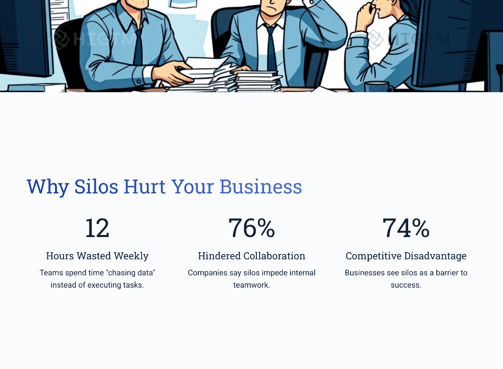

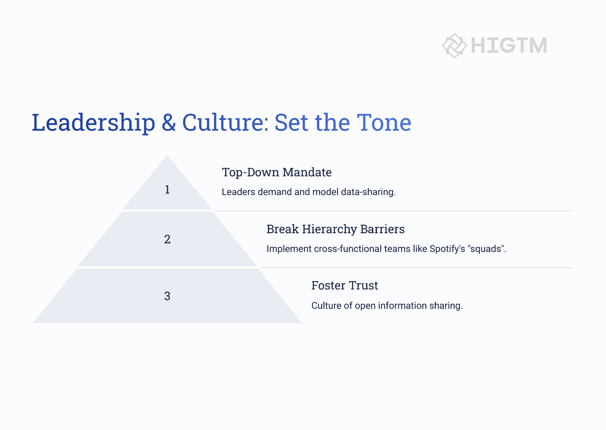

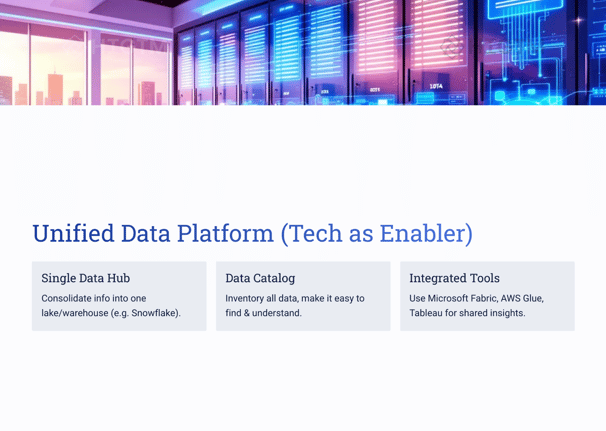

4. Reorganize into Cross-Functional Teams (When Appropriate)
Sometimes the org chart itself perpetuates silos. While you may not overhaul your entire structure, consider where cross-functional teams could replace siloed functions. The idea is to organize teams around outcomes or products rather than around narrow functions. Tech companies have famously done this with “squads” or product teams – Spotify’s model is an example, where a squad is a multidisciplinary team (developers, QA, designers, etc.) all focused on one feature fitting together, reporting jointly. This ensures daily collaboration by design. An SMB can apply a similar principle on a smaller scale.
For instance, a healthcare clinic chain could create a care improvement team that includes a doctor, a nurse, an IT analyst, and an admin staff, all working together to streamline patient experience across departments (rather than each role only answering to their functional manager). In a manufacturing SMB, instead of separate engineering and production teams rarely interfacing, you might set up an integrated product team: when developing a new product, assign engineers, a procurement specialist, a manufacturing planner, and a marketing rep to work as a unit from concept to launch. They will naturally share data (design specs, supplier info, market research, etc.) with each other throughout the process, rather than lobbing things over the wall.
Cross-functional teams break down silos in two ways: structurally and socially. Structurally, they remove hand-off points between departments (which is where information often stalls or gets lost). Socially, they build empathy – team members from different backgrounds start to understand each other’s perspectives and constraints. This empathy can then infect the wider organization. Google’s research on effective teams (Project Aristotle) found that a key element was psychological safety – people feeling safe to speak up and share. Cross-functional teams, by blending disciplines, can enhance psychological safety at the organizational level, because employees get used to interacting with a variety of colleagues, not just their silo mates.
One caution: implementing cross-functional teams requires clarity in roles and decision rights to avoid confusion. Make sure each such team has a clear mission and understands its autonomy. Also, you don’t have to reorganize everything overnight. Pilot a cross-functional approach on a critical project and see the results. If it improves speed or quality of output, gradually extend that model. Many SMBs find a hybrid structure works – keep departments for resource planning and basic management, but overlay cross-functional teams for executing key initiatives. The net effect is a matrix where information flows more freely than a strict silo hierarchy. It’s no coincidence that businesses highly effective at cross-department collaboration (and hence at feeding data to AI systems for insights) often have these matrix or team-of-teams structures enabling agility.
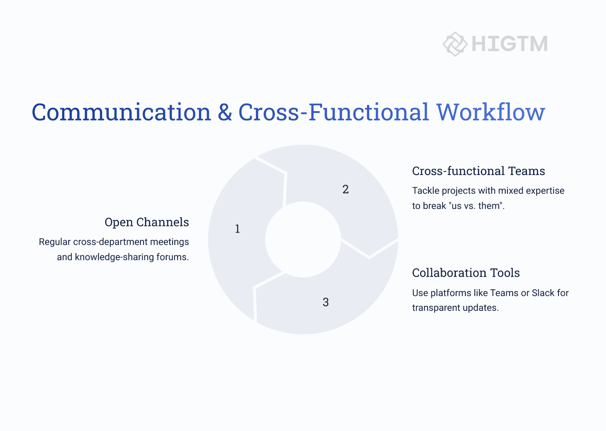

5. Implement a Single Source of Truth (Unified Data Platform)
While this guide emphasizes organizational strategy over pure tech, technology is a critical enabler for breaking data silos. To truly have all teams reading from the same playbook, you need to create a single source of truth for your data. This usually means consolidating disparate data sources into a centralized repository that all departments can access as needed. In practice, this could be a modern cloud data warehouse or data lake that ingests data from your various systems (CRM, ERP, marketing automation, etc.) in real-time or near real-time. Solutions like Snowflake or AWS’s cloud data lake are popular because they can be data types and scale as you grow. Microsoft Fabric is a newer entrant offering unified analytics across data lakes and warehouses – potentially very useful for SMBs already in the Microsoft ecosystem.
The goal is to break down the technical barriers that keep data siloed. For example, if retail stores, online ecommerce, and wholesale channels each had separate sales databases, unify them so that all sales data sits together. A data integration tool like AWS Glue can help extract and combine data from different sources. Once unified, any department can query the central database (with appropriate permissions) instead of submitting requests to another team’s analyst. This dramatically speeds up insights. One mid-sized retail chain discovered this benefit after integrating data from 600+ store databases into one cloud warehouse – they moved from nightly, store-by-store reports to instant enterprise-wide analytics managers from waiting on information.
To make your single source of truth usable, invest in a data catalog and governance. A data catalog (offered by tools like Informatica, Collibra, or even built-in to some platforms) describes the data – so an employee can search, “customer purchase history” and find where that data means, and how to request access. Good governance policies ensure the data remains consistent and secure, which builds trust. After all, if marketing pulls numbers from the central system and they don’t match finance’s numbers, people will revert to old habits. So, assign data stewards to maintain quality.
Real-world case: ORNL Federal Credit Union, mentioned earlier, recognized they lacked a single system of record and it hurt their reporting. They implemented a cloud data warehouse (with the help of a vendor) that unified data from multiple systems and presented “one truth” through dashboards. Immediately, they eliminated the confusion of multiple versions of reports and empowered e service BI off this hub. The SVP of data intelligence at ORNL FCU noted that having all data in one place not only improved decision speed but also reduced customer wait times in back employees could get answers faster. This underscores how unifying data isn’t just an IT project – it directly enhances customer experience and efficiency.
For SMBs aiming to adopt AI, a centralized data foundation is indispensable. Machine learning models need to pull in data from across the business – sales trends, customer interactions, supply chain metrics, etc. A single source of truth makes that feasible. It also simplifies compliance and security (you secure one place instead of dozens). Implementing a unified data platform can be a complex task, but cloud services and integrators (like the Ark Analytics platform used by ORNL FCU) have made it more accessible to mid-market companies. The bottom line: tear down the data walls by technically linking your systems under one umbrella, so every department trusts they’re working with the same facts.
6. Increase Data Transparency with Dashboards and Sharing Tools
Giving teams access to data is one step; making that data easy to consume and interpret is the next. Data transparency means that not only is the data centrally stored, but it’s readily visible and understandable to those who need it. One practical way to achieve this is through company-wide dashboards and reporting tools. Solutions like Tableau, Power BI, or Looker allow you to create live dashboards that can be filtered by department, region, product, etc., so everyone can slice the one truth to get the view they need. By deploying a set of shared dashboards (for example, a “Company Health Dashboard” showing sales, revenue, customer satisfaction, and operational KPIs in one place), you democratize insights. Marketing can see the sales numbers. Sales can see product delivery times. Support can see product quality metrics. When everyone sees the same figures just through different lenses, it enforces consistency and sparks cross-team conversations – “I notice our on-time delivery dropped last month, which might be why customer satisfaction dipped; what do you guys in operations think?”
In addition to dashboards, consider collaborative data tools. For instance, Google’s BigQuery and Microsoft Fabric allow multiple people to query data simultaneously and share queries. Even using Google Sheets or Office 365 with proper data links can ensure that there is a single live report that many eyes can see, rather than each team maintaining its own Excel sheet (a classic silo symptom). Some companies create an internal “data portal” – essentially a simple website or intranet page that links to key reports, data sets, and analysis across departments. It’s like a library of all approved information, open 24/7 to any employee.
Encourage a practice of data sharing in presentations as well. If the marketing team did a consumer analysis, have them post the slide deck on the intranet for others to learn from. When the finance team does an analysis of cost trends, share it in a cross-dept channel. This builds a knowledge base over time, accessible to all. Modern knowledge management tools (Confluence, Notion, SharePoint, etc.) can aid in organizing these insights.
Data transparency also benefits from narrative. Don’t just push raw data; encourage teams to annotate charts with explanations or host brief video walkthroughs of what the metrics mean. The more context employees have, the more likely they are to use the data appropriately and contribute back their interpretations.
There’s evidence that data transparency boosts alignment. A study cited in Dataversity highlighted how businesses implementing enterprise data catalogs and sharing saw improved data quality and decision-making, as users from different directoriess and correct them. Moreover, when **marketing can access real-time customer feedback collected*, they can pivot campaigns faster. When product development can see the support team’s log of customer complaints, they can implement fixes that have the biggest impact. These feedback loops only happen when data is transparent and flowing. As an example, consider a company like Apple: known for cross-functional collaboration, Apple ensures different teams work with shared data when deciding on product features – design, engineering, and marketing are all on board, so by launch time there’s alignment.
That level of coordination would be impossible if each group hid information. For an SMB, you might not be building iPhones, but the principle stands: when everyone can see and understand the data, they can act in concert. Transparency builds trust too, which is vital for any AI initiative – people trust the outputs if they know where the inputs came from.
7. Institute Data Governance with Cross-Department Stewards
As you open up data access, it’s crucial to keep the data organized, accurate, and secure. Otherwise, you risk chaos or mistrust that could send people scurrying back to their siloed spreadsheets. This is where data governance comes in – but not as a bureaucratic hammer, rather as an enabler of smooth sharing. Good data governance establishes who “owns” which data, who can access it, and how it should be formatted and maintained. The twist for silo-busting is to make governance a cross-department effort. Instead of each department dictating its own data definitions and quality criteria in isolation, form a data governance council or assign data stewards from each major department to collaborate on company-wide standards.
For instance, Sales, Marketing, and Finance might each have a slightly different way of defining “Active Customer.” A cross-functional data governance group can agree on a single definition (or at least map different terms) so that an “active customer” means the same in every report. This prevents the infamous scenario of dueling metrics, where each silo trusts only its numbers. When everyone agrees on data definitions, it’s a lot easier to share and trust each other’s data. According to an industry study by XPLM, a major barrier to silo elimination is that departments often **“do not want to share their data and have misaligned data semantics. A collaborative governance process helps counter that by giving all sides a voice in how data is managed and shared.
Data stewards in each department play a key role. A steward is like a librarian for their team’s data – responsible for cataloging data assets, ensuring data quality, and being the point person for data requests. If the marketing team needs some operations data, the ops data steward can facilitate and explain what’s available. Stewards from all departments should meet periodically to discuss issues like data cleanliness, integration needs, or access requests that span silos. This not only improves data quality but also builds relationships – stewards become ambassadors of their departments’ data to the rest of the company.
From a tool standpoint, consider implementing access control and security layers that make sharing safe. Part of governance is making sure, for example, that sensitive HR or healthcare data is only seen by the right people (to comply with laws like HIPAA or GDPR). Modern data platforms allow fine-grained access control – you can mask or restrict fields for certain roles. The governance team can outline these rules so that increased data sharing doesn’t mean free-for-all access to everything. When employees see that data is well-managed and that there’s a clear “source of truth” overseen by responsible stewards, they gain confidence in using data beyond their silo. That confidence is crucial when rolling out AI solutions for SMBs: users will feed the AI good data and trust AI-driven insights only if the underlying data governance is solid.
Finally, governance should also involve retrospectives and cleanup. Over years, silos might have created duplicate or conflicting records. A cross-team effort to clean master data (e.g., one unified customer list instead of five slightly different ones) is needed. It’s not the most glamorous work, but it pays off hugely. One Forrester report found that companies can spend 30% of their time **reconciling data and reload, unmanaged data. By investing some time in fixing these issues with all stakeholders present, you eliminate future waste and frustration. The takeaway: treat data as a shared asset with shared responsibility. Good governance is like the rules of the road – it lets everyone drive data to where it needs to go without crashes or confusion.
8. Invest in Training and Data Literacy for All Teams
Breaking silos isn’t just about moving data around; it’s also about moving minds. Employees need to feel capable of working with data that originally lived outside their domain. For example, if you give a supply chain person access to customer survey results, will they know how to interpret or use them? Or if marketing suddenly has finance metrics at their fingertips, do they understand them well enough to incorporate into planning? Training and data literacy programs can bridge these gaps, empowering everyone to make the most of shared data.
Start by assessing the current comfort level with data in each department. You may find, say, your sales team excels at relationship-building but isn’t used to digging into spreadsheets or BI tools. Meanwhile, your finance team might be very data-savvy but only in their accounting software, not in enterprise analytics. The aim of data literacy training is to create a common baseline of skills: understanding of key metrics, ability to use basic analytics tools, and knowledge of how to ask the right questions of the data. Many organizations host workshops or lunch-and-learns where one department teaches others about their data. For instance, have the Analytics or BI team run a session on how to navigate the new dashboards you’ve deployed, or how to perform simple SQL queries or use a tool like Tableau to drill down into a dataset.
Also, encourage a culture of continuous learning. Provide access to online courses or certifications (there are many affordable ones targeting data literacy for business users). Even something as straightforward as teaching everyone in the company how to do a pivot table in Excel or how to interpret a trend line can make a difference. When people feel competent, they’ll venture beyond their silo. When they feel ignorant or fear looking stupid, they retreat.
Critically, connect training to practical use cases. Adults learn best when solving real problems. Instead of abstract lessons, use cross-department data in examples: “Here’s how someone in HR could use operations data to forecast staffing needs,” for example. Maybe run a hackathon or data innovation day – mix people from different teams into small groups and give them a dataset (combined from multiple departments) with a challenge to find an insight or solve a problem. These exercises not only train but also reinforce the value of sharing data, as participants often have “aha!” moments discovering what another team’s data can do when combined with their own.
One real-world example: a mid-sized healthcare provider network recognized that nurses and administrators weren’t comfortable with the new data portal that combined clinical, financial, and operational data. They launched a “Data 101 for Healthcare” program, where they taught staff how to read combined reports (like linking patient outcomes with operational efficiency metrics). Over a few months, the staff went from avoiding the integrated system to actively using it to find improvement opportunities in patient care processes. This was pivotal in enabling their AI-driven scheduling system, because staff actually trusted and understood the system’s recommendations (which were based on a mix of data sources). In your SMB, building data literacy will likewise smooth the path for adopting AI tools – employees will feed the AI better data and will be able to interpret AI outputs appropriately.
Training isn’t one-and-done; make it ongoing. As you introduce new tools (maybe a new CRM or an AI analytics solution), update the training. Also encourage peer learning: when someone in finance figures out a neat way to visualize data that could help marketing, let them showcase it. Over time, you develop not just silo busters but data champions in every department, which creates a virtuous cycle of collaboration.
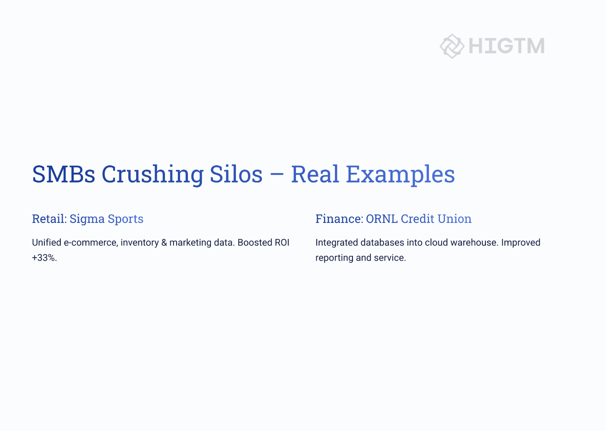

9. Recognize and Reward Collaborative Achievements
If you want behaviors to stick, recognition and rewards go a long way. We touched on aligning incentives earlier in terms of metrics and bonuses, but here we focus on the softer (yet powerful) side of human motivation: appreciation and validation. To solidify a culture of cross-department collaboration, make heroes out of the people and teams who exemplify it. When an employee goes above and beyond to help another department with data or insight, celebrate that publicly. When multiple teams come together to knock a project out of the park, tell that success story company-wide, highlighting how sharing information or working together was key to the win.
Many companies create awards specifically for collaboration – for example, an “Interdepartmental MVP” award each quarter. The winner could be chosen based on peer nominations describing how that person helped break a silo or contributed outside their own department. The prize might be small (a gift card, a trophy, a feature on the intranet), but the message is huge: we value teamwork over tunnel vision. Some organizations also reward teams, not just individuals. A cross-functional project team that achieves great results might earn a team bonus or a celebratory outing. Tying a portion of performance reviews to collaboration is another formal method – e.g., include a criteria like “Demonstrated cooperation and knowledge-sharing with other departments” in evaluations.
Case in point: a financial services SMB found that its analysts were very siloed, each servicing their own product line. Management decided to reward collaboration by launching an “Analysis of the Month” internal competition. To win, an analysis had to use data from at least two different departments. Analysts began teaming up – one from the loans team with one from the deposits team, for example – to produce reports that gave new insights (like how deposit customer behavior could signal loan opportunities). Winning teams got recognition from the CEO and a small bonus. This friendly contest spurred numerous collaborations that outlasted the competition itself, ultimately becoming the new normal. The byproduct was a richer combined dataset for the company to feed into its predictive models for customer churn and product upsell, directly boosting their AI initiatives in marketing.
Even without formal programs, managers should actively praise cross-team help. Did the IT team jump in to assist sales with a tricky data extraction? Mention it in the next meeting: “Big thanks to IT for helping sales analyze Q3 data – that’s the collaboration that drives us forward.” Positive reinforcement creates role models. New or hesitant employees see that “wow, collaboration is actually appreciated here,” and they’ll be more likely to step out of their silos too.
As collaboration becomes ingrained, you’ll notice a shift: employees start to derive intrinsic reward from the act of teaming up. They feel the success, they enjoy learning from others, and they realize their own job can be easier when they’re not doing everything alone. By initially bolstering that with recognition and reward, you accelerate reaching that tipping point.
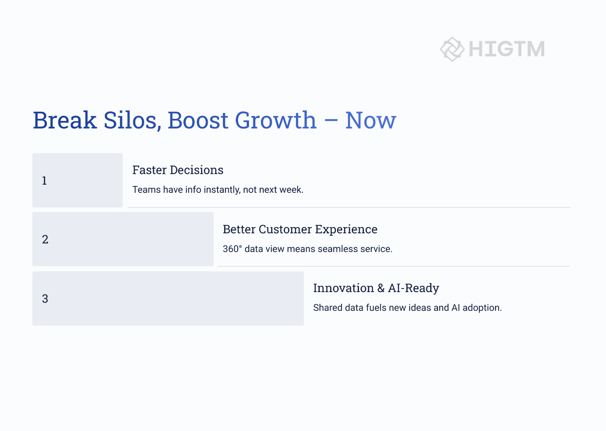

10. Tie Silo-Busting to Strategic Initiatives (Like AI Adoption)
People are more willing to change when they see a compelling purpose. One way to motivate your organization to break silos is to explicitly tie these efforts to exciting strategic initiatives – such as adopting AI, launching a new innovative product, or digital transformation. Make it clear that “if we want to leverage AI and modern analytics to outperform the competition, we must have our data unified and teams working together.” This creates a sense of urgency and importance around collaboration, rather than it feeling like just another internal housekeeping task.
SMBs often embark on projects like implementing an AI-driven CRM, or a predictive maintenance system in manufacturing, or a personalized medicine program in healthcare. Use these as rallying points. For example, say you plan to deploy an AI tool to predict customer churn. Announce to the team: “Our AI will only be as smart as the data we feed it. That means marketing, customer service, and product data all need to be connected and clean. Let’s all collaborate to make that happen, and this AI will help us retain customers and grow revenue.” Now, breaking silos has a direct line to a business outcome (customer retention) and a cool factor (AI). It’s not just abstractly “let’s share because sharing is nice,” it’s “let’s share because we have a mission that requires it.”
Weave silo-busting milestones into the strategic project plan. If the goal is AI adoption by Q4, then by Q2 maybe you need the data lake in place, by Q3 cross-functional data workshops done, etc. This anchors the collaboration drive to timelines and deliverables leadership cares about. It also gives an answer to “What’s in it for me?” when you ask teams to do the extra work of integration and cooperation. The answer is: “We will succeed in our AI project that makes everyone’s work easier / helps us beat the competition / drives bonuses, etc.”
A real-world instance of this: AMN Healthcare, a healthcare staffing company, undertook a modernization to become more data-driven and incorporate AI in workforce planning. In doing so, they moved to a single data platform (Snowflake) and emphasized breaking silos as key to the project’s success. The result was not only a 93% reduction in data storage costs, but also establishing a *single source that made advanced analytics possible. They communicated these wins as strategic, highlighting how unified data improved operational efficiency and enabled new analytics to optimize their business. The takeaway for employees: dismantling silos wasn’t just housekeeping, it was transforming the company and securing its future in an AI-powered industry.
So, identify your SMB’s big goals – whether it’s AI adoption, entering a new market, or improving customer experience – and make silo-busting the linchpin that will get you there. Paint a vivid picture: “In six months, when our new AI-driven system is live, every frontline employee will have instant insights from every department’s data on their screen – but we can only get there if we start sharing and integrating our data now.” This forward-looking approach turns breaking silos into a heroic journey that everyone can get behind, instead of a dull chore. It aligns personal motivation (learning AI, being part of something innovative) with the collective good of sharing data. When silo elimination is seen as the means to an exciting end, resistance tends to fade.
Turn AI into ROI — Win Faster with HIGTM.
Consult with us to discuss how to manage and grow your business operations with AI.
© 2025 HIGTM. All rights reserved.
